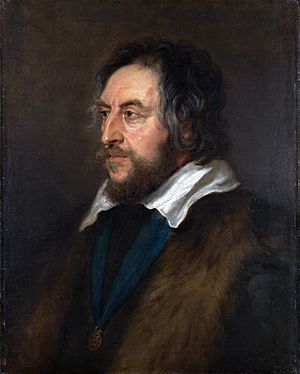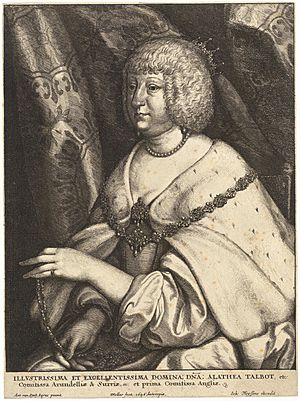Alethea Howard, Countess of Arundel facts for kids
Quick facts for kids Alethea Howard |
|
|---|---|
| Countess of Arundel | |
| Peter Paul Rubens, Alethea Talbot with attendants and Sir Dudley Carleton, c. 1620. Alte Pinakothek. | |
| Spouse(s) | Thomas Howard |
| Issue | |
| James Howard, Baron Maltravers Henry Howard, 15th Earl of Arundel William Howard, 1st Viscount Stafford Mary Anne Howard |
|
| Noble family | Talbot |
| Father | Gilbert Talbot, 7th Earl of Shrewsbury |
| Mother | Mary Cavendish |
| Born | 1585 Sheffield, Yorkshire, England |
| Died | 3 June 1654 Amsterdam, Netherlands |
Alethea Howard (born 1585, died 1654), also known as Lady Alethea Talbot, was an amazing woman from 17th-century England. She was a famous supporter of the arts and a keen art collector. She was also one of England's first published female scientists. Alethea was married to Thomas Howard, 21st Earl of Arundel. Together, they created one of the most important art collections in England during their time. She was the youngest daughter of Gilbert Talbot, 7th Earl of Shrewsbury and Mary Cavendish. Her sisters, Mary and Elizabeth, also became countesses.
Contents
Family Life and Children

Lady Alethea Talbot was born in Sheffield, Yorkshire, in 1585. In September 1606, she married Thomas Howard, who worked at the royal court. They had three sons who lived past infancy:
- James Howard, Baron Maltravers (1607–1624)
- Henry Frederick Howard, 22nd Earl of Arundel (1608–1652)
- William Howard, 1st Viscount Stafford (c. 1614–1680)
Sadly, Alethea outlived most of her children.
Life at the Royal Court
Alethea was involved in court life, performing in special plays called "masques." One famous masque she performed in was The Masque of Queens in 1609. This play was written by Ben Jonson and had costumes designed by Inigo Jones. In 1610, she also danced in another masque called Tethys' Festival.
Travels Abroad
Alethea loved to travel. In 1613, she and her husband joined the Elector Palatine Frederick V and Princess Elizabeth Stuart on their journey to Heidelberg after their wedding.
Alethea used her own money to buy back Arundel House, a family home. She also paid for their trip to Italy in 1613–1614, traveling with the famous architect Inigo Jones. Her husband, the Earl of Arundel, was one of the first Englishmen to buy ancient statues. They visited many cities like Rome, Naples, and Paris, returning to England in November 1614. When her father died in 1616, Alethea inherited a large sum of money, which helped her husband start his serious art collecting.
In 1620, the famous painter Peter Paul Rubens painted Alethea Talbot in Antwerp. At this time, she was traveling to Italy again. She wanted to visit her sons who were studying in Padua. She traveled alone, staying in places like Milan and Padua.
In 1622, she lived in Venice. During this time, there was a lot of fear in Venice about plots against the city. Alethea was warned to leave, but she bravely stayed. She even met with the leader of Venice, Doge Priuli, and the Venetian government to clear her name. She left Venice with letters from Priuli, showing she was respected. She then spent the winter in Turin with her sons and met the painter Anthony van Dyck.
In 1624, her oldest son, James, died from smallpox. In 1626, her husband was put in the Tower of London. This happened because their son had secretly married a relative of King Charles I without the King's permission. Later, King Charles I and Queen Henrietta Maria visited Arundel House to see the amazing art collections.
Return to England
In 1633, Lady Arundel bought a small house called Tart Hall. It was located near what is now Buckingham Palace. Her second son, Henry, became a member of the Dublin Parliament in 1634.
In 1638, Alethea faced financial problems, and her husband started thinking about a plan to move to Madagascar. Arundel House was filled with art, including many statues, busts, and inscriptions. The famous painter Artemisia Gentileschi might have worked for Alethea. Anthony van Dyck also painted a portrait of Lord and Lady Arundel.

Life in the Netherlands
In 1641, just before the English Civil War began, Alethea and her husband, along with their son William and his wife, moved to the Netherlands. Alethea was very independent and decided to travel to the Continent on her own. She met her husband in Utrecht.
She lived in Antwerp for a while, but after her husband died, she moved to Alkmaar. She asked Franciscus Junius, who had worked for them for 30 years, to organize their large collection of books. Later, she moved to Amersfoort and rented a beautiful house in Amsterdam.
When her husband, the Earl of Arundel, died, Alethea inherited their huge art collection. This included about 600 paintings and drawings by famous artists like Dürer, Holbein, Rembrandt, Rubens, Van Dyck, and Titian. There were also 200 statues and 5,000 drawings. She also inherited Arundel Castle and Arundel House.
In 1651, she gained the title of Baroness Furnivall. In 1652, her son Henry died. Alethea herself passed away in Amsterdam on June 3, 1654. An inventory of her collection after her death listed many masterpieces by artists like Titian, Giorgione, Tintoretto, and Da Vinci.
Legacy
After Alethea's death, her grandchildren claimed part of her inheritance. Her son, Henry, later inherited Arundel House. Her other house, Tart Hall, went to her uncle William.
Writing and Architecture
Like her sister Elizabeth, Alethea was interested in using herbs and food for medicine. Her recipes were published in a book called Natura Exenterata. Alethea's father was a supporter of early science, and Alethea herself wrote one of the first printed books about technical and scientific topics in England that was credited to a woman. This makes her one of England’s first published female scientists.
Alethea was also involved in designing and managing their homes. She helped with their house in Highgate, Arundel House on the Strand, and especially with her own house, Tart Hall, in St James's Park. Tart Hall was built with advice from a Catholic priest and a master builder.
Tart Hall, which no longer exists, was thought to look similar to the villas Alethea had seen in Italy. Records show how the house was furnished, including her bedroom with fabrics from India and a special room for displaying porcelain and other collections.

